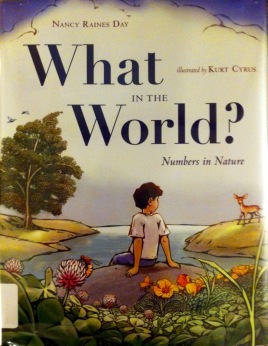Math meets nature. Here’s a great book to introduce number sets to young children.
 Title: What in the World? Numbers in Nature
Title: What in the World? Numbers in Nature
Written by: Nancy Raines Day
Illustrated by: Kurt Cyrus
Simon & Schuster, 2015, non-fiction
Suitable for ages: 4-8, grades K-3
Themes/topics: nature, numbers, sets
Opening: What in the world comes one by one?
A nose. A mouth. The moon. The sun.
Brief synopsis: (from Barnesandnoble.com) The natural world is full of sets of numbers: from birds’ wings in twos and clover leaves in threes to deer hooves in fours and octopus arms in eights. This book uses playful rhyming text to explore these numerical sets in vibrant detail, ending with the stars in the sky—a number set too big to count!
Links to resources:
Just get out there and start counting!
Choose a room, a habitat, an area where you live. Explore, count, categorize. Then take your lists and re-categorize the items in new ways. By shape, color, living/nonliving, function, animal/plant – stretch your mind to associate items in new ways.
Word work: Identify the rhymes. Generate more. Examine spelling differences.
Post the text for each number on posters around the room. Let children add to the lists with words or pictures.
Extend with books like these:
Mysterious Patterns: Finding Fractals in Nature, and Growing Patterns: Fibonacci Numbers in Nature by Sarah C. Campbell.
Why I like this book: The text is simple yet lyrical with lovely illustrations of nature. Each page is a springboard for generating more ideas. Kids as young as three could easily enjoy and participate in activities with this book. Great STEM potential!
Visit author Susanna Hill’s Perfect Picture Books for a plethora of picture books listed by title and topic/theme, each with teacher/parent resources.
Great introduction to counting.
LikeLiked by 1 person
What a wonderful way to introduce children to numbers. Thank you for sharing such a gem!
LikeLiked by 1 person
Simple book concept, but sounds like it’s got great layers. Thanks for sharing it.
LikeLiked by 1 person
Oooohhhh, I love cool science-y, math-y books. Gotta check it out! Thanks!
LikeLiked by 1 person
What a beautiful book about nature, science and math — all interconnected with our world. I love this book! Thanks for sharing!
LikeLiked by 1 person